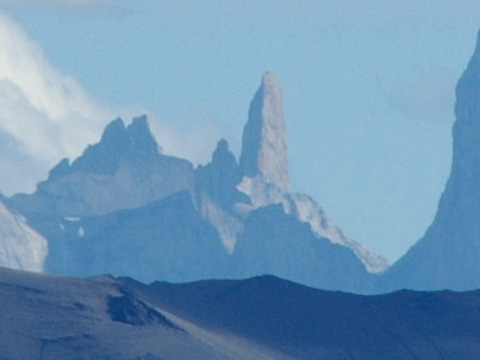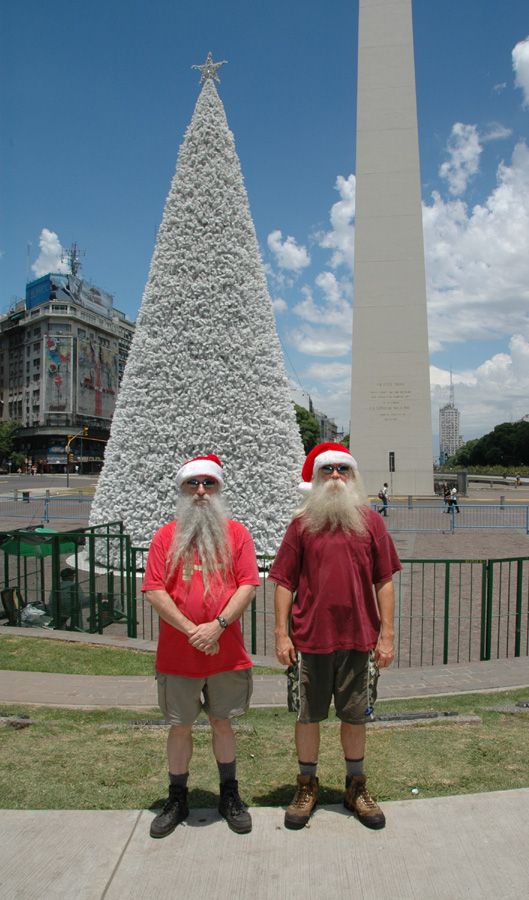Carey Get Out Your Cane
February 24th, 2009 3:35 pm by rayEveryone ought to travel with the words to Ozymandias in his wallet, but I am thinking, for the home stretch, (stretch is a bad phrasing when you fly economy) I should add the words to that touching Joni Mitchell song on “Blue”:
The wind is in from Africa
Last night I couldn’t sleep
Oh, you know it sure is hard to leave here Carey
But it’s really not my home
Dave did not mention in his last post, but after he had finished the “museum” circuit and a long lunch in Colonia, he was ready to LEAVE but the earlier ferry was full and we had to stand by our tickets. He is a vigorous traveler and I don’t think you will ever see him on the beach at Club Med unless there is something really important to do there. I was always a restless hitchhiker myself, but Dave beats all.
The lunch in Colonia was made considerably interesting by running into an American who lives everywhere, mostly France, and is apparently one of the Foremost Authorities on Chinese Astrology. She had been living in Buenos Aires for a while and comes to Colonia to refresh her tourist visa. I expect half of Colonia’s traffic is people renewing their Argentine visas for 90 days. It can be done indefinitely. Colonia’s small town museum scene does not disturb her. Museums, she said, I have lived most of my life in Europe, I don’t need museums.
They really were silly museums. Coalinga has more stuff in its museum than Colonia has in all of them put together. The silliest one of all is the “archive”, which consists of two glass cases filled with bits of broken bottles, and a couple of shelves of of books, closed, that you aren’t permitted to touch. So you look at their institutional bindings: Municipal court records, 1853-1854.
The astrologer said that we were lucky to have found the restaurant we were in.
Wednesday we took our bike ride along the barren industrial shore and saw one big lizard and some ducks. And a condom wrapper. It was the wrong time of day. I went back to San Telmo in the afternoon to buy a brass mortar and pestle because my suitcase didn’t weigh enough yet. We spent the afternoon packing and even went around the corner to buy a souvenir mate cup for $18 because there were some air molecules left in the pack. Then we got in a taxi and made him turn on his meter. For some reason the last couple of days we’ve been getting taxis who want to leave their meters off.
We left Argentina at 2330 Hrs on a long flight for a place which really is home, Dave’s mother’s house in Denver. It is my privilege, in trip planning, that we have enough time and money not to have to make long connecting flights. I am so unimpressed by 36 hour transits to the Seychelles or anywhere you shouldn’t even bother to go if you don’t have the time to make a leisurely time getting there. However, there aren’t any easy flights to Argentina. They are all overnight, and I connected us through Miami to Denver after a two hour layover (which is really foolish in its own right, considering that we had to come through immigration and our bags weren’t checked through). The first plane was early and there weren’t any delays. Connecting out of Miami after a night on an airplane is still probably more pleasant than staying in Miami. We got to Denver and Dave’s mother was pleased to see us and three hours later she was pleased to see Dave’s sister and her family and if she ever became not pleased she didn’t let on, even though it’s a considerable strain for her to deform her routine (which is already deformed by age and doctors) to accommodate kids.
Annika appears to have liked the dress we got her in Urumqi, even though the sequins were all ending up on the carpet. To Quinn we gave a Gauchito Gil t-shirt, which I could see getting banned by his school on the grounds of overly specific religious sentiment and gang colors (it’s bright red.)
On Saturday Jill and her crew flew home, and on Sunday morning we flew home. A storm was coming the other direction and it was bumpy. Boris met us at Oakland Airport and we stopped to buy food at Sigona’s (Dave and Boris went to El Grullense for tacos) and then we were actually home. I thought on the drive up how pretty Highway 84 is in the fog, and how this would be a nice drive to a hotel even if we didn’t live here.
The house is as we left it. The pin machine even sets the same pins rocking as when we left.
And so, Inshallah, until next time, hasta, ciao, bis später, zai jian.
Maybe I’ll go to Amsterdam
Or maybe I’ll go to Rome
And rent me a grand piano and put some flowers round my room
But let’s not talk about fare-thee-wells now
The night is a starry dome.
And they’re playing that scratchy rock and roll
Beneath the Matala moon
Matala is a real place, by the way. I found it on Google Maps. It’s on the south coast of Crete and I expect it is overrun by 60-year-old businessmen who wonder if they missed something and so rent a condo and go to the Starbucks in the Mermaid Cafe.
It’s better this way. Joni Mitchell gave an interview to the Rolling Stone in 1971 in which she mentions among many other things, that the owner of the Mermaid Cafe was arrested and tortured by the Greek authorities (Greece was under military rule at the time) for hosting so many hippies and decadents.
At least Greece didn’t send them to Morocco to be tortured. What? You really expected Obama to end the policy of indefinite detention of Afghanis without charge, and the kidnapping of individuals to send to foreign prisons to prevent their cases being ever heard of by the lapdog courts and press in this country? Silly you. I bet you thought he was going to take back a few of the trillion dollars that were stolen by bankers and brokers and redistribute it to the people from whom it was taken, too.
See you in an appliance carton under the bridge. Inshallah.

